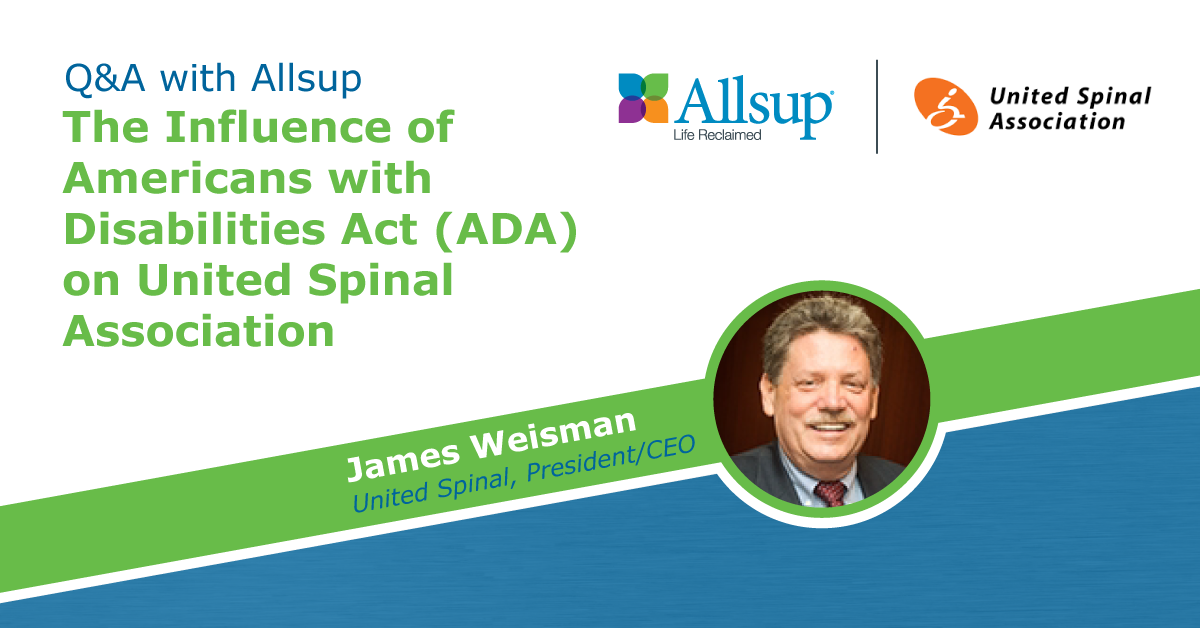Allsup Q&A with United Spinal Association – The Influence of the Americans with Disabilities Act (ADA)

Allsup is joining with organizations nationwide in 2020 to celebrate 30 years of progress achieved with the Americans with Disabilities Act, which was signed into law on July 26, 1990. A dedicated advocate for decades, James Weisman, president and CEO of United Spinal Association, shares his perspective on the ADA’s anniversary and importance for people with disabilities.
Q: How did United Spinal Association become involved with ADA? How is your organization involved now?
A: United Spinal Association was founded in 1946 by paralyzed veterans, and called Eastern Paralyzed Veterans Association (EPVA) until the early 2000s. Its mission since 1946 has been to facilitate living effectively and independently in the community. We have always been a membership organization comprised of people with spinal cord injuries and disorders (SCI/D). Our national membership is currently about 58,000.
I have been a disability rights lawyer for 43 years, and came to work here 41 years ago. In September 1979, we sued New York City and its transit authority, winning in 1984. The settlement required accessible buses, “key” accessible rail stations and paratransit. In 1986, we sued the city of Philadelphia and SEPTA, its transit system, and reached a similar agreement in 1988. Also, in 1988, we were active in getting the Fair Housing Amendments Act to address disability. Our members were primarily Vietnam veterans—some drafted, some enlisted, but none prepared to live a life of isolation because of disabilities acquired as young adults. They wanted to live the American dream. They grew up in a time of civil rights, and banded together with the disability community at large to promote the rights of people with disabilities throughout the 1970s and ’80s.
Our organization and others that were active in the disability rights movement of the ’70s and ’80s were the ones involved in drafting, lobbying for and promoting the passage of ADA. There were no transit experts willing to assist the disability rights movement when ADA was being drafted or discussed with Congress. United Spinal Association/EPVA had beaten the two largest, oldest rail systems in the U.S. (NYC and Philadelphia), and by default, we got involved on the transit issues, and then the Act in general. The transit provisions of the ADA are based on the settlement agreements reached with NYC and Philadelphia.
Enforcing the ADA, educating people with disabilities, professionals, and manufacturers of equipment and products about needs and rights, and ensuring that new products and services, as well as old products that were traditionally inaccessible, are made accessible has occupied our advocacy agenda now. Our biggest advocacy victory of late is making NYC’s yellow cab system and Ubers accessible. In addition to being advocates, we have become ADA consultants to architects, real estate developers, the tech industry—including autonomous vehicles—and manufacturers of durable medical equipment. We operate a policy office in Washington, D.C., that deals with rights, healthcare and disabled veterans’ issues.
Q: Can you discuss the status for individuals with disabilities before ADA was established? What propelled the efforts behind this legislation?
A: Perhaps ADA’s greatest gift is the creation of a collective consciousness between and among people with disabilities about their rights. It raised expectations about the potential for living lives of both success and satisfaction in both the disabled and non-disabled populations. Prior to ADA, it was difficult to define disability discrimination. “Special” programs, unnecessarily segregated for people with disabilities, were motivated by kindness, because prior to special programs, there were none at all.
People with disabilities lived in institutions, were supported by charities or family/friends, but were largely ignored and overlooked. During the ’70s, institutions were emptied, and the “normalization” push provided substandard, subsistence-level existences for people with mental and physical disabilities living in the community. Normalization did not include transportation or employment, opportunities to recreate, or even go down a curb ramp to get off the block. In 1975, Congress passed the Individuals with Disabilities Education Act (IDEA), which required a free public education for every child with a disability in America, integrated to the maximum extent feasible and appropriate to the child’s needs. Disability advocacy of the ’70s and ’80s propelled the ADA, but until ADA, there was no national focus on the rights of people with disabilities, little respectful language or behavior regarding people with disabilities, or efforts to include them.
Q: How has ADA changed the way United Spinal serves people with disabilities? How do your goals align with ADA’s objectives? How do you believe the act will continue to affect the people you serve?
A: The ADA is a tool for both consciousness-raising and promoting the rights of people with disabilities. It is a guide to how right-thinking employers, proprietors of places of public accommodation, and state and local governments should consider disability-related matters. Its implementing regulations tell builders, transit operators, employers and governments how to comply. This has made life easier for disability advocates, as they can point to the Act’s mandates, instead of local laws or moral imperatives.
Q: What are your thoughts on the outcome of ADA’s accomplishments 30 years after it was enacted?
A: It is easy to see that the ADA’s most effective provisions are the ones that apply to the built environment and transportation. The word “bus” now means “accessible bus.” Able-bodied people notice when things are inaccessible. Accessibility is much easier to achieve and evaluate than attitudinal change. Thirty years of ADA have seen new stadiums, schools, office buildings, apartment buildings, vehicles and technology become accessible to people with disabilities. Sometimes accessibility is spotty, or even nonexistent, but everyone agrees that inaccessibility is wrong and that, in time, it will be remedied.
Employment, however, is abysmal: 65% of adults with disabilities, ages 18-65, do not work. The numbers were the same pre-ADA. There are two main reasons, in my opinion, for this phenomenon. The first is that until the Affordable Care Act, people with disabilities trying to go to work risked losing healthcare coverage for pre-existing conditions, as they also lost their Medicaid coverage. The second, of course, is employers’ reluctance to hire and promote people with disabilities, especially those with emotional and intellectual impairments.
Q: How do you envision the next wave of change being implemented for ADA in the future? What still needs work? What other initiative would you like to see happen?
A: Autonomous vehicles must be accessible. Affordable, accessible housing, both single-family housing and multiple dwellings, must provide access, as Americans will be living and working longer than they ever have, and need to be accommodated. Airlines are very difficult for wheelchair users and have resisted change for decades. The shortage of homecare workers and basic support services that allow people to live and work effectively in the community, rather than reside in institutions or be completely dependent, is a challenge that we’ll be forced to confront as the Baby Boomer generation ages. Boomers and people with disabilities will need community-based supports and services.
In 1984, when we settled for “key” stations, I was sure that by 2020, Americans who had gone to school with and worked side by side with people with disabilities would have seen to it that all stations in existing transit systems were made accessible. It is necessary and doable.
COVID-19 will be the ADA’s largest assignment. Millions of Americans will be asking for reasonable accommodation and needing it, because of compromised immune systems—either their own, or people they live with. For example, ADA entitles people receiving chemotherapy to request work-from-home because of the dangers of working in an office setting or using public transportation. It even protects the spouse of that person, should the danger be real and unable to be accommodated. ADA requires reasonable accommodation, and not everyone’s job can be done from home, but employers must be sensitive to the needs and rights of their employees with disabilities and ADA is the perfect guide.
Q: The ADA’s 30th anniversary fell approximately 100 days from Election Day in November. The voices and actions of individuals with disabilities are clearly essential in the fight for equality, in terms of voting rights and legislative activities. What do you think are the most crucial steps to ensure those with disabilities have an equal say in democracy?
A: Disability rights advocates have always felt a duality of purpose. The desire to motivate people with disabilities to get involved in disability issues, to participate in civic events, and influence government policy based on their status of disability, is undermined by the parallel desire to assimilate and eliminate the stigma of disability.
It is empowering to influence government policy. Organizing and promoting the rights of people with disabilities depends on nurturing a “next generation” of advocates. It is imperative for people with disabilities to vote in their interests, and to let elected officials know that they do. We recently had a wheelchair user appointed to the Board of Directors of the Metropolitan Transportation Authority of New York, which covers NYC, Long Island and the northern suburbs. His presence will be hard to ignore, as crucial decisions about service are made. His voice will be heard for the first time as an equal, as opposed to a citizen imploring board members to meet the needs of the community.
The success of the disability rights movement to come depends on assimilated people with disabilities, i.e., those that work in non-disability related professions, to lead the way in their industries, and to continue to advocate for those with disabilities coming up behind them.
Allsup
Related Articles

Disability
Lupus Awareness Month: Making Lupus Visible

Disability
Navigating Work After Cancer: Free Cancer and Careers Events

Disability
Consistency & Community Matters: Brain Injury Awareness Month

